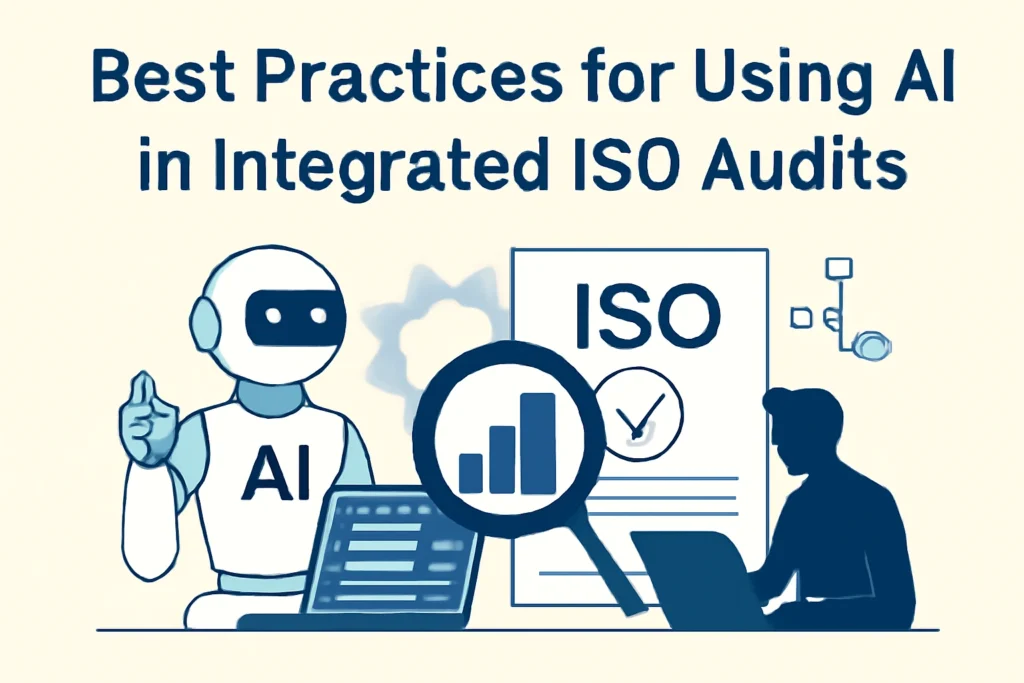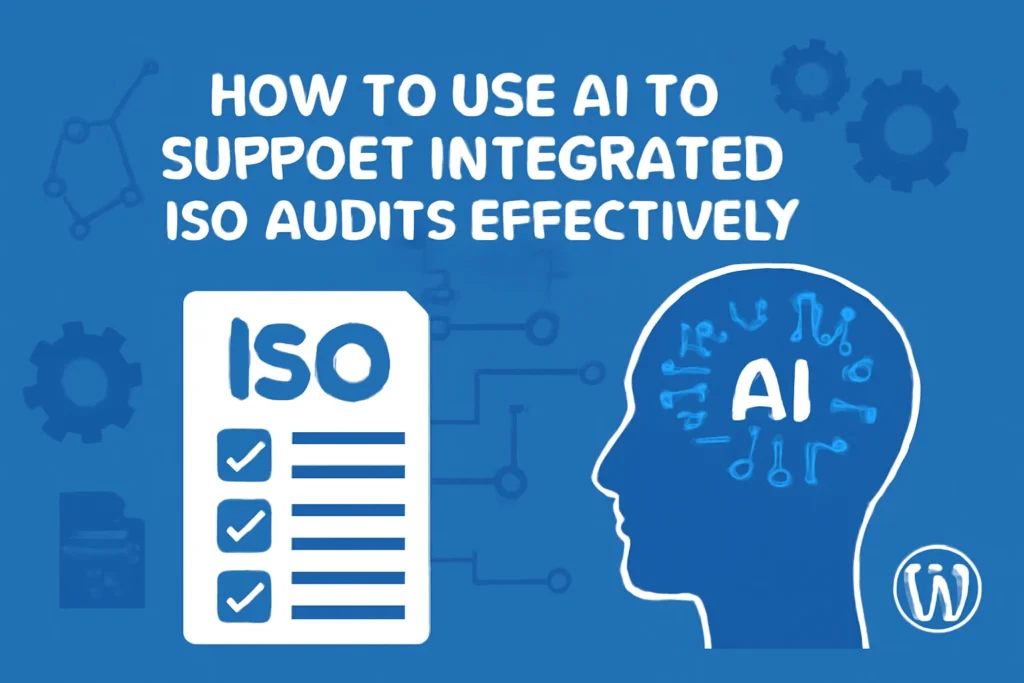Introduction to AI in Integrated ISO Audits
ISO audits play a central role in ensuring compliance, risk management, and trust within any organization, particularly when multiple management systems are involved. When businesses adopt an integrated ISO approach, such as combining ISO 9001 for quality, ISO 27001 for information security, and the emerging ISO 42001 for AI governance, the audit process becomes more efficient and unified. Understanding how to use AI to support integrated ISO audits is key, as artificial intelligence adds value by automating data analysis, supporting continuous monitoring, and streamlining decision-making within management systems, allowing auditors to focus on higher-level insights and long-term compliance improvements.
Understanding Integrated ISO Audits
An integrated ISO audit combines multiple ISO standards into a single, streamlined audit process. Instead of conducting separate audits for ISO 9001 (quality management), ISO 27001 (information security), ISO 14001 (environmental management), or ISO 42001 (AI governance), organizations align them into one framework. This integrated management system reduces duplication, saves costs, and improves efficiency while ensuring compliance across different areas and aligning with ISO 9001 requirements. By exploring how to use AI to support integrated ISO audits, auditors can enhance risk assessment, gap analysis, and continuous monitoring, leading to a more proactive approach to compliance, audit readiness, and overall business performance.
Role of Artificial Intelligence in ISO Audits
AI Technologies Used in Audits
AI introduces machine learning, NLP, data analytics, and automation to simplify ISO audits. These tools analyze large datasets, detect anomalies, and automate repetitive tasks. By supporting ISO 9001, ISO 27001, and ISO 42001 processes, AI systems optimize audit planning, streamline documentation, and improve compliance efficiency.
AI in Risk Management and Compliance
AI enhances risk management through continuous monitoring and data-driven decision-making, as AI can monitor risks in real-time. Integrated ISO audits benefit from predictive analytics that identify vulnerabilities early, allowing organizations to implement AI effectively. This proactive risk management ensures compliance with ISO standards, reduces errors, and strengthens the overall audit framework.
AI in Quality and Information Security
AI supports ISO 9001 by improving quality management and customer satisfaction while enhancing ISO 27001 compliance for information security. With AI tools, organizations can track performance, detect risks, and strengthen data protection, making integrated ISO audits more reliable and effective.
How to Use AI to Support Integrated ISO Audits
Automating the Internal Audit Process
AI systems streamline internal audits by automating scheduling, data analysis, and reporting dashboards, which enhances the ISO management system. This reduces manual effort, saves time, and ensures greater accuracy in integrated ISO audits, which is critical for effective ISO management systems. Organizations can track compliance across ISO 9001, ISO 27001, and ISO 42001 more efficiently with AI-powered automation, facilitating their ISO certification process.
AI for Gap Analysis and Continuous Monitoring
AI tools help auditors identify non-conformities across multiple ISO standards and assist in the AI audit process. With real-time monitoring and gap analysis, businesses can detect issues early, improve compliance readiness, and maintain continuous improvement within integrated management systems.
Enhancing Auditor Efficiency with AI Tools
By automating repetitive tasks, AI allows auditors to focus on high-value activities like risk assessment and decision-making. This improves audit quality, strengthens compliance with ISO frameworks, and enhances overall efficiency of integrated audits by aligning with key performance indicators.
| ISO Standard | AI Application | Benefits |
|---|---|---|
| ISO 9001 | AI-driven quality checks | Improved customer satisfaction |
| ISO 27001 | AI monitoring & risk detection | Stronger data security |
| ISO 42001 | AI governance tools | Better AI risk management |
| ISO 14001 | AI in environmental data | Reduced environmental risks |
Best Practices for Using AI in Integrated ISO Audits
Ensure Compliance with ISO 42001
ISO 42001 provides a framework for governing AI systems and managing AI-related risks. Organizations should align audit processes with this standard to ensure responsible use of AI and comply with the EU AI Act, particularly regarding the clauses that govern AI applications. By combining AI governance with integrated ISO audits, compliance, transparency, and risk management improve significantly, as AI can monitor these processes effectively.

Balance Human Judgment with AI Insights
AI supports auditors through automation, data analysis, and risk detection, but human expertise remains essential, especially in interpreting the results related to the use of AI systems. Auditors should use AI insights as decision-making tools, ensuring balanced, accurate, and ethical results during ISO 9001, ISO 27001, and ISO 42001 audits.
Proactive Risk-Based Auditing with AI
AI enables proactive risk-based auditing by identifying trends, predicting issues, and supporting continuous monitoring, which is crucial for an integrated AI approach. This approach reduces non-conformities, strengthens compliance, and drives ongoing improvement across integrated management systems, ensuring adherence to multiple standards.
Deep Dive into Credit Card Compliance Audits
AI is transforming how organizations manage compliance, from ISO standards to financial regulations, making it essential for maintaining ISO certification. When exploring how AI supports risk management and compliance audits, it’s worth learning more about how to get a credit card lawsuit dismissed easily. This perspective highlights how governance and compliance strategies overlap across industries.
Building a Strong Digital Foundation for ISO Standards
Integrated ISO audits rely on strong digital systems and AI-driven solutions for efficiency. To explore AI, compliance, and digital transformation beyond audits, check out the latest resources on the use of AI systems in various sectors. Techy Infinity for more detailed guides, insights, and practical resources on building future-ready management systems.
Frequently Asked Questions (FAQs)
What is an integrated ISO audit?
An integrated ISO audit combines multiple ISO standards, such as ISO 9001, ISO 27001, ISO 14001, and ISO 42001, into a single process to save time and improve efficiency while ensuring compliance with multiple standards.
How does AI improve ISO 9001 audits?
AI enhances ISO 9001 audits by automating quality checks, analyzing customer feedback, and providing data-driven insights to improve quality management systems.
Can AI tools support ISO 27001 compliance?
Yes, AI tools support ISO 27001 compliance by detecting security threats, monitoring risks, and ensuring continuous protection of information assets.
What is ISO 42001 and how does it relate to AI?
ISO 42001 is the global standard for AI management systems. It provides governance, risk management, and compliance frameworks for trustworthy AI use, aligning with ISO 31000 principles.
Which AI tools are best for integrated management systems?
AI tools for data analysis, automated dashboards, machine learning, and continuous monitoring are widely used to support integrated management systems.
Does AI replace auditors in ISO audits?
No, AI does not replace auditors; rather, it enhances their capabilities in managing AI risks. Instead, it assists them by automating repetitive tasks, allowing auditors to focus on decision-making, compliance strategies, and managing AI risks.
How can AI help in continuous monitoring for ISO compliance?
AI enables continuous monitoring by analyzing data in real-time, identifying non-conformities, and supporting proactive risk management across ISO standards, ensuring compliance with the EU AI Act.
What are the risks of using AI in ISO audits?
Risks include overreliance on AI tools, data privacy concerns, and potential bias in automated decision-making if AI governance is not properly applied under ISO 42001.
Conclusion
AI is reshaping integrated ISO audits by improving compliance, automating data analysis, and supporting continuous monitoring across standards like ISO 9001 and ISO 27001, while also addressing AI risks. While AI tools bring speed and accuracy, the role of human auditors remains essential for judgment and ethical decision-making, especially when evaluating the use of AI systems. ISO 42001 offers a strong framework to govern AI use responsibly, ensuring trust and accountability. Looking ahead, AI will continue to act as a transformative force in compliance and auditing, helping organizations build resilient and future-ready management systems while addressing AI risks and the clauses of the EU AI Act.


